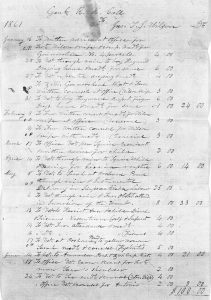I frequently contribute to a column on The Root online magazine, where I respond with Henry Louis Gates Jr. to genealogical questions from the readers. Often the questions involve trying to trace families back to the slavery period, which is a daunting and difficult task. Not only are records hard to come by, but the work can be an emotional rollercoaster.
It is mixed with the delight of finding an ancestor listed by name in a probate record, quickly followed by the realization that they are there because they were property. It can be hard to face the realities of the past when seeing children listed with monetary values next to their names, but also rewarding to know you have pieced a family together with the record.
Unfortunately, these are the types of records you hope for when conducting slave research. You have to dig deep into a slave owner’s probate and account files in the hopes that people are mentioned by name as a part of their property. The type of records that can hide there are sometimes surprising. The article I worked on recently, “What’s the Story of a Portrait of My Slave Ancestor?,” found me browsing page by page through Richard Keith Call’s probate file. Call was a former Governor of Florida and he owned two plantations and hundreds of slaves. He died in 1862, prior to Emancipation, and his probate file includes lists of his slaves from both plantations. I was acquainted with his probate from a previous column, also for The Root, but discovered something new this time.
[It] is very clear that these are entries for medical services for Call’s slaves.
Digging deeper into the probate file than I had done before, I found a number of pages of account records for the local doctor, Dr. John T.J. Wilson, for the years immediately prior to and following Richard Keith Call’s death. These could have been easy to overlook, but if you read the entries and compare them to the list of slaves in the probate, it is very clear that these are entries for medical services for Call’s slaves. The entries include a range of services from the care of wounds and conditions to the prenatal care and delivery of a number of babies.
Most of the entries include the name of the individual or individuals being treated, which can provide an intimate look at the lives of those enslaved on Call’s plantations. In the recent article for The Root, we were searching for a young man named Hanover whose brother, Hayward, was living with him and his wife, Bettie, in 1880. They all would have been children when Richard Keith Call died.
This account record notes the dressing of Hayward’s hand...
This account record notes the dressing of Hayward’s hand and an amputation of his finger a few days later. A later entry in the probate file notes that Hayward was not well, suggesting that maybe he was living with his brother in 1880 because he could not support himself. These are details we would never know without this record.
There are also entries that reveal much about the conditions on the plantation, including a number of charges for consultations and medication for the treatment of venereal disease. There were also recurrent visits for the abstraction of teeth and the use of medication for rheumatic conditions that speak to the toll a life in slavery took on the body. This record reveals a part of these ancestors’ experiences that is not typically documented, making this a rare and exciting find even though it is also records a heartbreaking reality.
Share this:
About Meaghan E.H. Siekman
Meaghan holds a Ph.D. in history from Arizona State University where her focus was public history and American Indian history. She earned her B.A. in history from Union College in Schenectady, New York, the city where she grew up. Prior to joining the NEHGS team, Meaghan worked as the Curator of the Fairbanks House in Dedham, Massachusetts, as an archivist at the Heard Museum Library in Phoenix, Arizona, and wrote a number of National Register Nominations and Cultural Landscape Inventories for the National Park Service. Meaghan is passionate about connecting people with the past in meaningful and lasting ways. She enjoys finding interesting anecdotes about an ancestor to help bring the past to life.View all posts by Meaghan E.H. Siekman →
